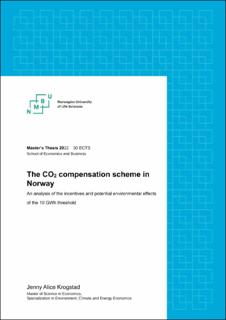| dc.contributor.advisor | Rosendahl, Knut Einar | |
| dc.contributor.advisor | Garcia, Roberto | |
| dc.contributor.author | Krogstad, Jenny Alice | |
| dc.coverage.spatial | Norway | en_US |
| dc.date.accessioned | 2022-08-02T10:44:27Z | |
| dc.date.available | 2022-08-02T10:44:27Z | |
| dc.date.issued | 2022 | |
| dc.identifier.uri | https://hdl.handle.net/11250/3009763 | |
| dc.description.abstract | The EU Emission Trading System’s goal is to put a price on carbon to internalize the external costs of emissions. In Europe, non-renewable resources still constitute a large share of the inputs in electricity production. The cost increase of utilizing non-renewables is thus transferred to the electricity prices. The CO2 compensation scheme, or the indirect cost compensation regulation, is a voluntary scheme that countries can adopt to support carbon leakage exposed sectors to avoid carbon leakage due to climate policies. Norway is one of the countries who have decided to do so, and the payments are expected to surge within the coming years. The compensations are calculated based upon the production level or electricity consumption level and EUA prices, and to be eligible for compensation the electricity consumption must exceed 10 GWh per year. The thesis looks at the effects of this threshold on businesses’ decision to increase electricity consumption to become eligible for compensation. By assessing the compensation’s share of the cost increase linked to increased electricity consumption, I find that, for all but one eligible industry category analyzed, the compensation makes up between 16 % to 105 % of the cost increase under different EUA prices. The evidence shows that, in most approaches, the compensation scheme can be beneficial for Norwegian businesses moving up to the threshold, and that the compensation scheme might incentivize increased electricity consumption. I also discuss that the Norwegian electricity system, who is largely characterized by high shares of renewable electricity consumption, in combination with the compensation scheme might lead to unintended effects on competition and emissions across the European Economic Area. | en_US |
| dc.description.abstract | EUs kvotesystem har som mål å sette en pris på karbon for å internalisere de eksterne kostnadene knyttet til utslipp av klimagasser. I Europa utgjør fortsatt ikke-fornybare energikilder en stor del av innsatsfaktorene brukt i produksjon av elektrisitet. Dette gjør at kostnadene knyttet til bruken av slike ressurser smitter over på prisen for elektrisitet. CO2 kompensasjonsordningen, eller reguleringen for kompensasjon av indirekte kostnader, er en frivillig ordning land kan velge å implementere for å støtte industrier som er særlig utsatt for karbonlekkasje. Norge er ett av landene som har valgt å gjøre dette, og utbetalingene er forventet å øke kraftig i takt med økningen av kvoteprisen i EU de neste årene.
Kompensasjonen beregnes ut fra produksjonsnivå eller elektrisitetsbruk og prisen på kvoter, og for å kvalifisere til kompensasjon må elektrisitetsforbruket overskride 10 GWh per år. Denne oppgaven ser på hvilke effekter dette terskelnivået har på bedriftenes beslutning til å øke strømforbruket for å kvalifisere til kompensasjonsutbetalinger. Jeg finner at kompensasjonen utgjør mellom 16 % og 105 % av kostnadsøkningen under forskjellige kvotepriser for alle unntatt én industrigruppe. I de fleste scenarioene viser resultatene at kompensasjonsordningen kan være veldig fordelaktig for norske bedrifter, og at ordningen kan oppmuntre til økt elektrisitetsforbruk for å kvalifisere til kompensasjon. Jeg finner også at det norske strømmarkedet, som i stor grad karakteriseres av høy andel fornybar energi, kombinert med kompensasjonsordningen, kan ha utilsiktede konkurranse- og klimaeffekter i det europeiske økonomiske samarbeidsområdet. | en_US |
| dc.language.iso | eng | en_US |
| dc.publisher | Norwegian University of Life Sciences, Ås | en_US |
| dc.rights | Attribution-NonCommercial-NoDerivatives 4.0 Internasjonal | * |
| dc.rights.uri | http://creativecommons.org/licenses/by-nc-nd/4.0/deed.no | * |
| dc.title | The CO2 compensation scheme in Norway : an analysis of the incentives and potential environmental effects of the 10 GWh threshold | en_US |
| dc.type | Master thesis | en_US |
| dc.description.localcode | M-ECON | en_US |

